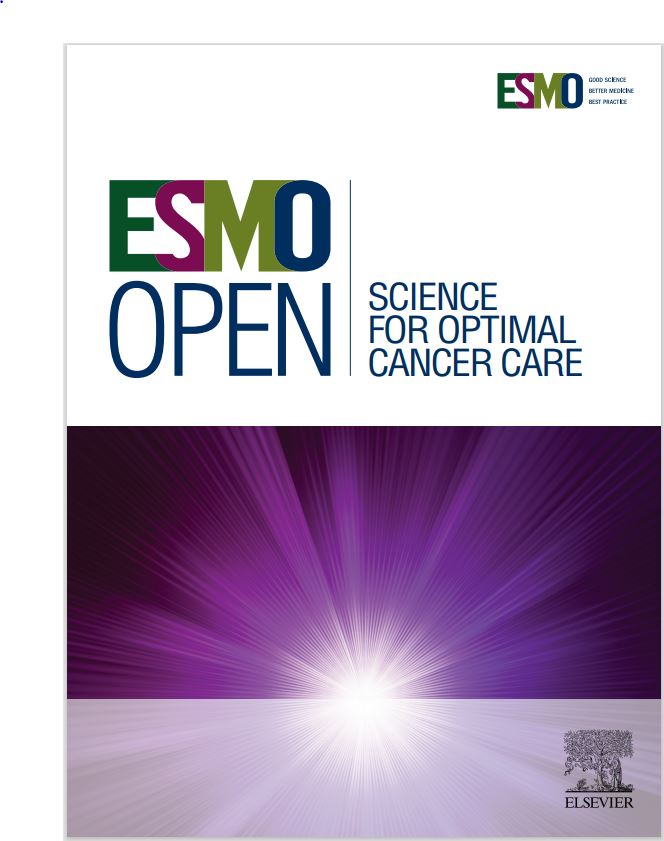开发两种机器学习模型来预测从原发性HER2-0乳腺癌到低her2转移的转化:一项概念验证研究。
IF 7.1
2区 医学
Q1 ONCOLOGY
引用次数: 0
摘要
背景:由于抗her2抗体-药物偶联物可用于her2低转移性乳腺癌患者,her2低表达在乳腺癌(BC)中获得了临床意义。在疾病发展过程中,her2 -低状态的不稳定性被广泛报道,这凸显了识别HER2-0原发性BC患者在复发时可能发展为her2 -低表型的必要性。为了应对最大限度地获得治疗的紧迫性,我们利用人工智能来预测这种情况的发生。患者和方法:我们纳入了一个大型的多中心回顾性队列,这些患者在复发时接受了组织重新采样。对数据集进行预处理,以解决数据缺失、特征丰富和目标类不平衡等相关问题。然后我们训练了两个模型:一个专注于可解释性[极限梯度增强(XGBoost)],另一个专注于性能(XGBoost和支持向量机的集成)。结果:本研究共纳入1200例患者。在386例HER2-0原发性BC患者和复发时匹配的HER2状态中,42.5% (n = 157)转化为HER2低表型。可解释模型的平衡准确率为58%,灵敏度为53%,特异性为64%。该模型最重要的变量是原发性BC表型[平均Shapley值(SHAP) 0.540]、原发性BC组织学类型(SHAP 0.101)、分级(SHAP 0.182)和复发部位(SHAP 0.008-0.213)。该集合模型的平衡精度为64%,灵敏度为75%,特异性为53%。结论:这项工作代表了机器学习模型的第一个概念验证应用之一,用于预测现代BC肿瘤学中药物获取的高度相关现象。从一个可解释的模型开始,随后将其与集成方法集成,使我们能够在保持透明性、可解释性和可理解性的同时增强性能。本文章由计算机程序翻译,如有差异,请以英文原文为准。
Development of two machine learning models to predict conversion from primary HER2-0 breast cancer to HER2-low metastases: a proof-of-concept study
Background
HER2-low expression has gained clinical relevance in breast cancer (BC) due to the availability of anti-HER2 antibody–drug conjugates for patients with HER2-low metastatic BC. The well-reported instability of HER2-low status during disease evolution highlights the need to identify patients with HER2-0 primary BC who may develop a HER2-low phenotype at relapse. In response to the urgency of maximizing treatment access, we utilized artificial intelligence to predict this occurrence.
Patients and methods
We included a large multicentric retrospective cohort of patients with BC who underwent tissue resampling at relapse. The dataset was preprocessed to address relevant issues such as missing data, feature abundance, and target class imbalance. We then trained two models: one focused on explainability [Extreme Gradient Boosting (XGBoost)] and another aimed at performance (an ensemble of XGBoost and support vector machine).
Results
A total of 1200 patients were included in this study. Among 386 patients with HER2-0 primary BC and matched HER2 status at relapse, 42.5% (n = 157) converted to a HER2-low phenotype. The explainable model achieved a balanced accuracy of 58%, with a sensitivity of 53% and a specificity of 64%. The most important variables for this model were primary BC phenotype [mean Shapley value (SHAP) 0.540], primary BC histological type (SHAP 0.101), grade (SHAP 0.182), and sites of relapse (SHAP 0.008-0.213). The ensemble model had a balanced accuracy of 64%, with a sensitivity of 75% and a specificity of 53%.
Conclusions
This work represents one of the first proof-of-concept applications of machine learning models to predict a highly relevant phenomenon for drug access in modern BC oncology. Starting with an explainable model and subsequently integrating it with an ensemble approach enabled us to enhance performance while maintaining transparency, explainability, and intelligibility.
求助全文
通过发布文献求助,成功后即可免费获取论文全文。
去求助
来源期刊

ESMO Open
Medicine-Oncology
CiteScore
11.70
自引率
2.70%
发文量
255
审稿时长
10 weeks
期刊介绍:
ESMO Open is the online-only, open access journal of the European Society for Medical Oncology (ESMO). It is a peer-reviewed publication dedicated to sharing high-quality medical research and educational materials from various fields of oncology. The journal specifically focuses on showcasing innovative clinical and translational cancer research.
ESMO Open aims to publish a wide range of research articles covering all aspects of oncology, including experimental studies, translational research, diagnostic advancements, and therapeutic approaches. The content of the journal includes original research articles, insightful reviews, thought-provoking editorials, and correspondence. Moreover, the journal warmly welcomes the submission of phase I trials and meta-analyses. It also showcases reviews from significant ESMO conferences and meetings, as well as publishes important position statements on behalf of ESMO.
Overall, ESMO Open offers a platform for scientists, clinicians, and researchers in the field of oncology to share their valuable insights and contribute to advancing the understanding and treatment of cancer. The journal serves as a source of up-to-date information and fosters collaboration within the oncology community.
 求助内容:
求助内容: 应助结果提醒方式:
应助结果提醒方式:


